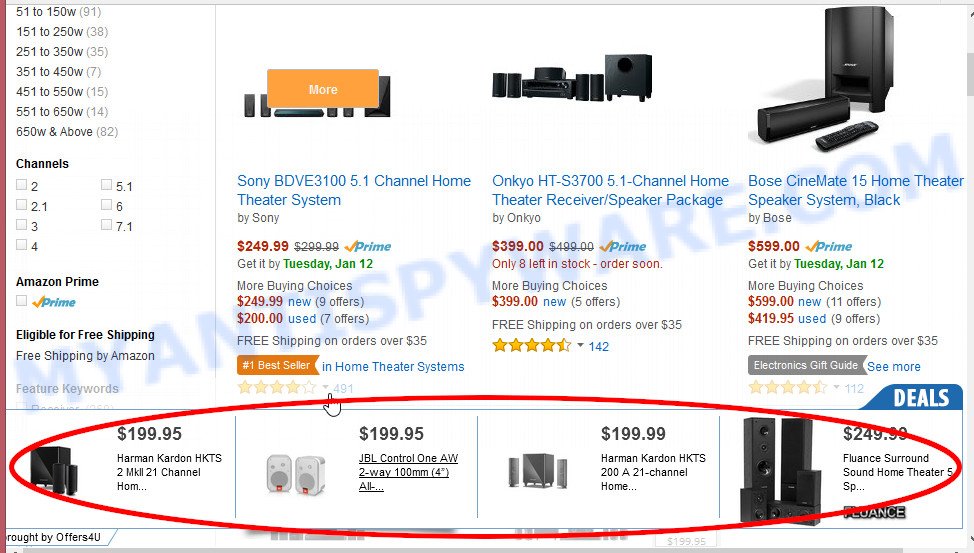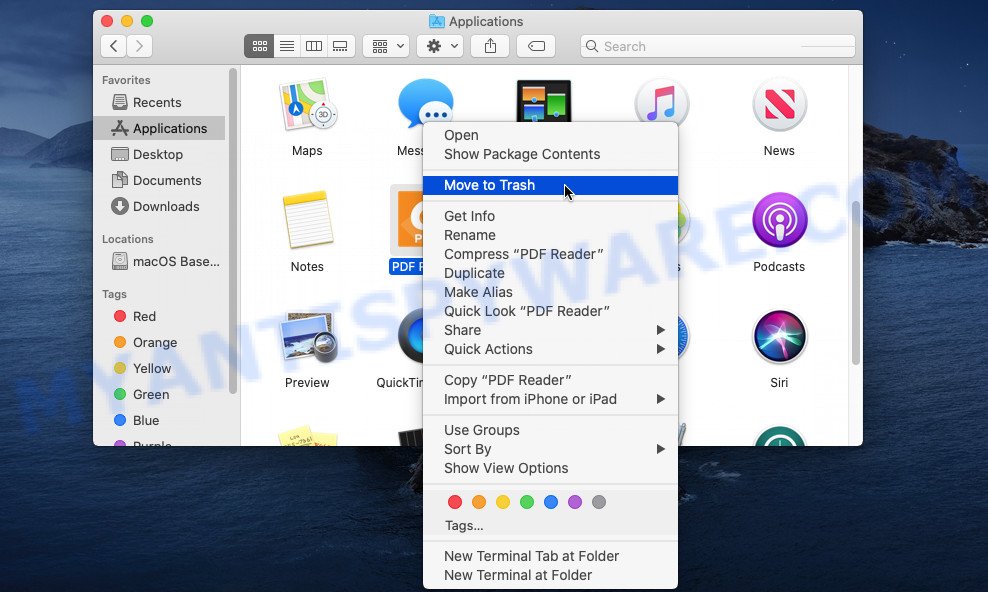What is PublicConsoleSearch
PublicConsoleSearch is supposed to be a program that will improve the browsing experience, but according to security specialists, this application is adware. Adware is a form of malicious software related to unwanted advertising. Some adware software will bring up advertisements when you is surfing the Web, while other will build up a profile of your surfing habits in order to target ads. In general, adware have to be installed on your Mac, so it’ll tend to be bundled with other software in much the same method as potentially unwanted apps (PUAs).

Unwanted ads
PublicConsoleSearch can bombard you with endless ads and pop-up windows that could potentially be dangerous for you. Moreover, it can modify browser settings and install malicious browser add-ons. Another reason why you need to delete adware is its online data-tracking activity. PublicConsoleSearch can be used to collect your surfing history and user info, including passwords and credit card numbers. In the future, your confidential data can be sold to third parties.
The tutorial below explaining steps to get rid of PublicConsoleSearch. Feel free to use it for removal of the adware that may attack Mozilla Firefox, Safari and Google Chrome and other popular Mac web-browsers. The instructions will allow you remove adware and thereby clean your web browser from any unwanted ads.
How does PublicConsoleSearch get on your MAC
Usually, adware software gets into your MAC OS as part of a bundle with freeware, sharing files and other unsafe apps that you downloaded from the Internet. The creators of adware pays software creators for distributing adware within their applications. So, third-party apps is often included as part of the installation package. In order to avoid the setup of any adware software: select only Manual, Custom or Advanced installation type and reject all third-party programs in which you are unsure.
Threat Summary
| Name | PublicConsoleSearch, PublicConsoleSearch 1.0 app |
| Type | adware software, potentially unwanted application (PUA), Mac malware, Mac virus |
| Detection Names | Trojan-Downloader.OSX.Adload, Osx.Adware.Cimpli, Adware/Adload!OSX, OSX.Trojan.Gen, Program:MacOS/Vigram.A, ApplicUnwnt, Adware.MAC.Generic and MacOS.Agent-MT |
| Distribution | Free software installers, torrent downloads, shady pop-up advertisements and fake update tools |
| Symptoms | The web-page links redirect to a web sites different from what you expected, unexpected advertisements appear on web-sites that you are visiting, new entries appear in your Applications folder, unexpected browser extensions or toolbars keep coming back, your web browser homepage has changed without your permission, slow Internet browsing speeds. |
| Removal | PublicConsoleSearch removal guide |
How to Remove PublicConsoleSearch adware (removal tutorial)
Adware is a form of malicious software that you might have difficulty in removing it from your MAC system. Thankfully, you have found the effective PublicConsoleSearch removal guide in this blog post. Both the manual removal way and the automatic removal method will be provided below and you can just select the one that best for you. If you have any questions or need help then type a comment below. Certain of the steps below will require you to exit this webpage. So, please read the step-by-step tutorial carefully, after that bookmark it or open it on your smartphone for later reference.
To remove PublicConsoleSearch, perform the following steps:
- Remove unwanted profiles on Mac device
- Uninstall PublicConsoleSearch related applications through the Finder
- Remove PublicConsoleSearch related files and folders
- Scan your Mac with MalwareBytes
- Remove PublicConsoleSearch from Safari, Chrome, Firefox
- How to stay safe online
- Finish words
Remove unwanted profiles on Mac device
PublicConsoleSearch can install a configuration profile on the Mac system to block changes made to the browser settings. Therefore, you need to open system preferences, find and delete the profile installed by the adware software.
Click Apple menu ( ![]() ) > System Preferences.
) > System Preferences.

In System Preferences, select Profiles. if there is no Profiles in the list of preferences, that means there are no profiles installed on the Mac device. If there is Profiles in the list, then click on it, then select a profile related to PublicConsoleSearch.

To delete a malicious profile, click on the minus button ( – ) located at the bottom-left of the Profiles screen.
Uninstall PublicConsoleSearch related applications through the Finder
Some adware, browser hijackers and PUPs may be removed by uninstalling the free applications they came with. If this way does not succeed, then looking them up in the list of installed programs in the Finder. Use the “Move to Trash” command in order to get rid of them.
Open Finder and click “Applications” as shown on the image below.

You will see a list of programs installed on your MAC system. We recommend to pay maximum attention to the program you installed last. Most likely, it’s the PublicConsoleSearch adware. If you’re in doubt, you can always check the program by doing a search for her name in Google, Yahoo or Bing.

Once the program which you need to uninstall is found, simply right press on its name, and choose “Move to Trash”.
Don’t forget, choose Finder, then “Empty Trash”.
Remove PublicConsoleSearch related files and folders
Now you need to try to find PublicConsoleSearch related files and folders, and then delete them manually. You need to look for these files in certain directories. To quickly open them, we recommend using the “Go to Folder…” command.
PublicConsoleSearch creates several files, these files must be found and removed. Below is a list of files associated with this unwanted application.
- /Library/LaunchDaemons/com.PublicConsoleSearch.system.plist
- ~/Library/LaunchAgents/com.PublicConsoleSearch.service.plist
- /Library/Application Support/.(RANDOM)/System/com.PublicConsoleSearch.system
- ~/Library/Application Support/.(RANDOM)/Services/com.PublicConsoleSearch.service.app
Some files created by PublicConsoleSearch are hidden from the user. To find and delete them, you need to enable “show hidden files”. To do this, use the shortcut CMD + SHIFT + . Press once to show hidden files and again to hide them. There is another way. Click Finder -> Applications -> Utilities -> Terminal. In Terminal, paste the following text: defaults write com.apple.finder AppleShowAllFiles YES

Press Enter. Hold the ‘Option/alt’ key, then right click on the Finder icon in the dock and click Relaunch.

Click on the Finder icon. From the menu bar, select Go and click “Go to Folder…”. As a result, a small window opens that allows you to quickly open a specific directory.

Check for PublicConsoleSearch generated files in the /Library/LaunchAgents folder

In the “Go to Folder…” window, type the following text and press Go:
/Library/LaunchAgents

This will open the contents of the “/Library/LaunchAgents” folder. Look carefully at it and pay special attention to recently created files, as well as files that have a suspicious name. Move all suspicious files to the Trash. A few examples of files: com.machelper.plist, installapp.plist, com.net-preferences.plist, macsearch.plist, com.google.defaultsearch.plist, , com.PublicConsoleSearch.service.plist and search.plist. Most often, browser hijackers, adware and potentially unwanted programs create several files with similar names.
Check for PublicConsoleSearch generated files in the /Library/Application Support folder

In the “Go to Folder…” window, type the following text and press Go:
/Library/Application Support

This will open the contents of the “Application Support” folder. Look carefully at its contents, pay special attention to recently added/changed folders and files. Check the contents of suspicious folders, if there is a file with a name similar to com.PublicConsoleSearch.system, then this folder must be deleted. Move all suspicious folders and files to the Trash.
Check for PublicConsoleSearch generated files in the “~/Library/LaunchAgents” folder

In the “Go to Folder…” window, type the following text and press Go:
~/Library/LaunchAgents

Proceed in the same way as with the “/Library/LaunchAgents” and “/Library/Application Support” folders. Look for suspicious and recently added files. Move all suspicious files to the Trash.
Check for PublicConsoleSearch generated files in the /Library/LaunchDaemons folder
In the “Go to Folder…” window, type the following text and press Go:
/Library/LaunchDaemons

Carefully browse the entire list of files and pay special attention to recently created files, as well as files that have a suspicious name. Move all suspicious files to the Trash. A few examples of files to be deleted: com.search.system.plist, com.PublicConsoleSearch.system.plist, com.machelper.system.plist, com.installapp.system.plist and com.macsearch.system.plist. In most cases, adware, browser hijackers and potentially unwanted programs create several files with similar names.
Scan your Mac with MalwareBytes
If you’re still having issues with the PublicConsoleSearch removal or just wish to check your Mac occasionally for adware software and other malware, then download MalwareBytes. It’s free for home use, and scans for and removes various undesired applications that attacks your MAC or degrades Apple Mac performance. MalwareBytes AntiMalware can remove toolbars, adware, potentially unwanted programs and browser hijackers as well as malicious software, including ransomware and trojans.

Installing the MalwareBytes AntiMalware (MBAM) is simple. First you will need to download MalwareBytes Anti-Malware (MBAM) from the following link.
21174 downloads
Author: Malwarebytes
Category: Security tools
Update: September 10, 2020
Once downloading is complete, run it and follow the prompts. Click the “Scan” button . MalwareBytes program will scan through the whole computer for the PublicConsoleSearch adware. This task can take quite a while, so please be patient. While the tool is checking, you can see number of objects and files has already scanned. Make sure all items have ‘checkmark’ and click the “Quarantine” button.
The MalwareBytes AntiMalware (MBAM) is a free program that you can use to remove all detected folders, files, malicious services and so on.
Remove PublicConsoleSearch from Safari, Chrome, Firefox
Annoying PublicConsoleSearch adware or other symptoms of adware in your browser is a good reason to locate and remove harmful extensions. This is an easy way to restore internet browsers settings and not lose any important information.
You can also try to remove PublicConsoleSearch by reset Chrome settings. |
If you are still experiencing problems with PublicConsoleSearch removal, you need to reset Firefox browser. |
|
How to stay safe online
If you browse the Net, you can’t avoid malvertising. But you can protect your internet browser against it. Download and use an ad-blocker application. AdGuard is an ad-blocker which can filter out a lot of of the malicious advertising, blocking dynamic scripts from loading malicious content.

- Installing the AdGuard is simple. First you will need to download AdGuard by clicking on the link below. Save it on your Microsoft Windows desktop.
AdGuard for Mac download
3885 downloads
Author: © Adguard
Category: Security tools
Update: January 17, 2018
- After the downloading process is done, run the downloaded file. You will see the “Setup Wizard” program window. Follow the prompts.
- Once the installation is complete, press “Skip” to close the installation program and use the default settings, or click “Get Started” to see an quick tutorial that will help you get to know AdGuard better.
- In most cases, the default settings are enough and you do not need to change anything. Each time, when you start your machine, AdGuard will run automatically and stop annoying ads, block harmful and misleading web sites.
Finish words
Now your MAC should be free of the PublicConsoleSearch adware. We suggest that you keep AdGuard (to help you block unwanted ads and unwanted harmful web sites) and MalwareBytes Free (to periodically scan your MAC OS for new adwares and other malware).
If you are still having problems while trying to remove PublicConsoleSearch from the Google Chrome, Mozilla Firefox and Safari, then ask for help here here.

















